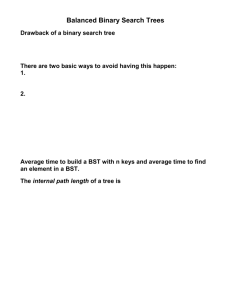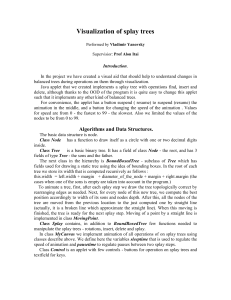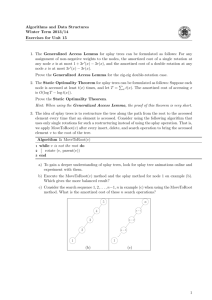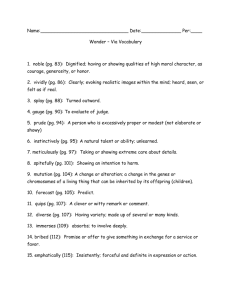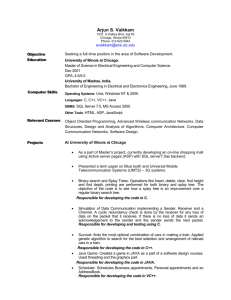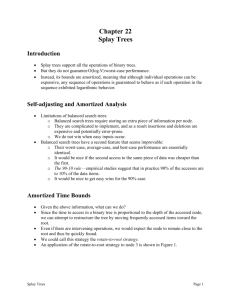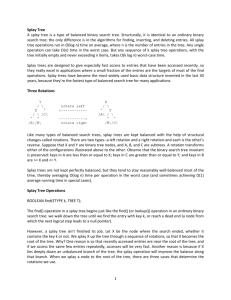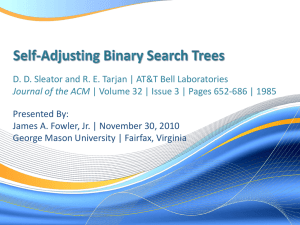CSE 326 Splay Trees
advertisement
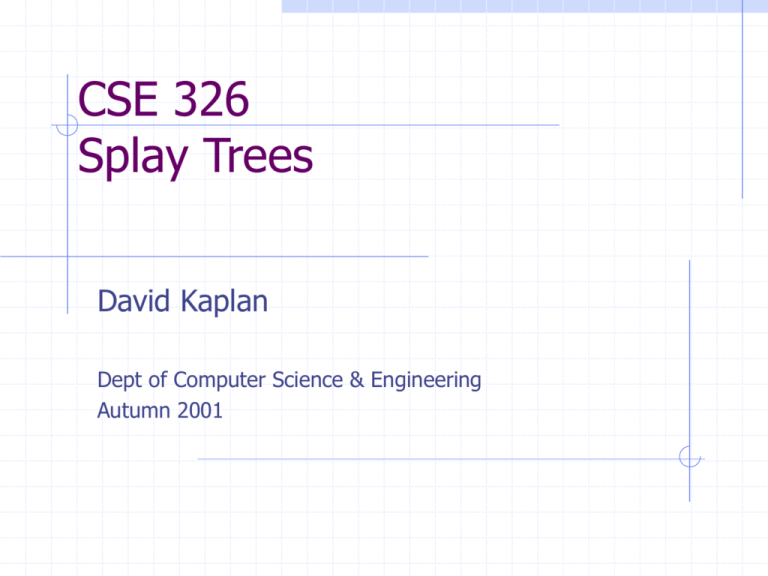
CSE 326
Splay Trees
David Kaplan
Dept of Computer Science & Engineering
Autumn 2001
Motivation for Splay Trees
Problems with AVL Trees
extra storage/complexity for height fields
ugly delete code
Solution: splay trees
Splay Trees
blind adjusting version of AVL trees
amortized time for all operations is O(log n)
worst case time is O(n)
insert/find always rotates node to the root!
CSE 326 Autumn 2001
2
Splay Tree Idea
10
You’re forced to make
a really deep access:
17
Since you’re down there anyway,
fix up a lot of deep nodes!
5
2
9
3
Splay Trees
CSE 326 Autumn 2001
3
Splaying Cases
Node being accessed (n) is:
Root
Child of root
Has both parent (p) and grandparent (g)
Zig-zig pattern: g p n is left-left or right-right
Zig-zag pattern: g p n is left-right or right-left
Splay Trees
CSE 326 Autumn 2001
4
Access root:
Do nothing (that was easy!)
X
Splay Trees
root
root
n
n
Y
X
CSE 326 Autumn 2001
Y
5
Access child of root:
Zig (AVL single rotation)
root
p
root
n
n
p
Z
X
Splay Trees
Y
X
Y
CSE 326 Autumn 2001
Z
6
Access (LR, RL) grandchild:
Zig-Zag (AVL double rotation)
g
n
p
X
g
p
n
W
X
Y
Splay Trees
Y
Z
W
Z
CSE 326 Autumn 2001
7
Access (LL, RR) grandchild:
Zig-Zig
Rotate top-down – why?
n
g
p
p
W
Z
n
g
X
Y
Y
Splay Trees
Z
CSE 326 Autumn 2001
W
X
8
Splaying Example:
Find(6)
1
1
2
2
zig-zig
3
3
Find(6)
4
6
5
Splay Trees
5
6
CSE 326 Autumn 2001
4
9
… still splaying …
1
1
2
6
zig-zig
3
3
6
2
5
Splay Trees
4
5
4
CSE 326 Autumn 2001
10
… 6 splayed out!
1
6
6
1
zig
3
2
3
5
2
4
Splay Trees
5
4
CSE 326 Autumn 2001
11
Splay it Again, Sam!
Find (4)
6
6
1
1
zig-zag
3
4
Find(4)
2
5
4
Splay Trees
3
5
2
CSE 326 Autumn 2001
12
… 4 splayed out!
6
4
1
1
6
zig-zag
3
4
3
5
5
2
2
Splay Trees
CSE 326 Autumn 2001
13
Why Splaying Helps
If a node n on the access path is at depth d before
the splay, it’s at about depth d/2 after the splay
Exceptions are the root, the child of the root, and the node
splayed
Overall, nodes which are below nodes on the access
path tend to move closer to the root
Splaying gets amortized O(log n) performance. (Maybe
not now, but soon, and for the rest of the operations.)
Splay Trees
CSE 326 Autumn 2001
14
Splay Operations: Find
Find the node in normal BST manner
Splay the node to the root
Splay Trees
CSE 326 Autumn 2001
15
Splay Operations: Insert
Ideas?
Can we just do BST insert?
Splay Trees
CSE 326 Autumn 2001
16
Digression: Splitting
Split(T, x) creates two BSTs L and R:
Splay Trees
all elements of T are in either L or R (T = L R)
all elements in L are x
all elements in R are x
L and R share no elements (L R = )
CSE 326 Autumn 2001
17
Splitting in Splay Trees
How can we split?
Splay Trees
We have the splay operation.
We can find x or the parent of where x should be.
We can splay it to the root.
Now, what’s true about the left subtree of the root?
And the right?
CSE 326 Autumn 2001
18
Split
split(x)
splay
T
L
R
OR
L
x
Splay Trees
CSE 326 Autumn 2001
R
L
>x
<x
R
x
19
Back to Insert
x
split(x)
L
<x
R
>x
L
R
void insert(Node *& root, Object x)
{
Node * left, * right;
split(root, left, right, x);
root = new Node(x, left, right);
}
Splay Trees
CSE 326 Autumn 2001
20
Splay Operations: Delete
x
find(x)
delete x
L
R
L
<x
R
>x
Now what?
Splay Trees
CSE 326 Autumn 2001
21
Join
Join(L, R): given two trees such that L < R, merge them
L
splay
L
R
R
Splay on the maximum element in L, then attach R
Splay Trees
CSE 326 Autumn 2001
22
Delete Completed
x
find(x)
T
delete x
L
R
L
<x
R
>x
Join(L,R)
T-x
Splay Trees
CSE 326 Autumn 2001
23
Insert Example
4
4
6
6
split(5)
1
1
6
1
9
9
9
2
4
2
7
7
7
5
2
4
Insert(5)
6
1
Splay Trees
CSE 326 Autumn 2001
9
2
7
24
Delete Example
6
6
1
1
9
4
4
find(4)
6
9
2
7
9
2
2
1
7
Find max
7
2
2
6
Delete(4)
Splay Trees
1
1
6
9
7
CSE 326 Autumn 2001
9
7
25
Splay Tree Summary
Can be shown that any M consecutive operations starting
from an empty tree take at most O(M log(N))
All splay tree operations run in amortized O(log n) time
O(N) operations can occur, but splaying makes them
infrequent
Implements most-recently used (MRU) logic
Splay tree structure is self-tuning
Splay Trees
CSE 326 Autumn 2001
26
Splay Tree Summary (cont.)
Splaying can be done top-down; better because:
only one pass
no recursion or parent pointers necessary
There are alternatives to split/insert and join/delete
Splay trees are very effective search trees
relatively simple: no extra fields required
excellent locality properties:
frequently accessed keys are cheap to find (near top of tree)
infrequently accessed keys stay out of the way (near bottom of tree)
Splay Trees
CSE 326 Autumn 2001
27
